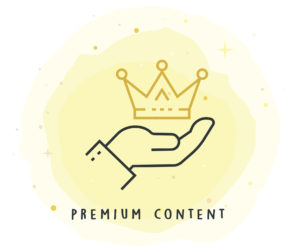How to Use Premium Content in a Content Marketing Strategy
 Content marketing has become a critically important marketing tactic.
Content marketing has become a critically important marketing tactic.
Most of the content marketers create – such as blog posts, tips, articles, and videos – is free.
But if you’re using content marketing to generate leads and sales, especially for inbound B2B marketing, you also need to create “premium” content.
What is premium content and how do you use it in a smart marketing strategy?
Here are some answers in part one of a three-part series.
Understanding Premium Content
Premium content is original information of such high value to your customers and prospects about a topic of such great interest that visitors to your website will be willing to provide their contact information to get it.
Premium content:
- Is directly relevant to the business of your customers and prospects: It focuses on a subject you are often asked about by customers and that customers are dealing with every day;
- Provides guidance on a key issue or challenge that matters a great deal to customers or prospects, a topic with potentially significant impact on their business;
- Answers questions, offers advice, or shares knowledge from someone at your company who is an authority on the subject.
To access premium content, site visitors complete a web form with their name, title, company name, and contact information. B2B marketers also typically ask a qualifying question to learn a bit more about the prospect’s needs, such as their company size or whether they’re planning to make a purchase in the near future.
Once the visitor submits the form, the premium content is made available via a web link or email.
Common Types of Premium Content
Here are some of the most popular formats for premium content:
- eBook: Typically 15-30 pages, very visual with a designed cover and designed pages; usually presented as a PDF;
- White paper: An in-depth evaluation or profile of a subject or issue, supported by research and written by a subject matter expert or a team of experts; typically 6-10 pages in length and a PDF;
- Original research: A report of proprietary research you’ve conducted on a critical or timely topic; also very visual, with charts and infographics displaying data and results; also usually a PDF;
- Webinar: A web presentation of content by an expert sharing a presentation deck or presenting live online; can be recorded and shared on your website to extend its shelf life;
- Interactive tools or templates: Content that helps a prospect measure or assess something in their business or provides a framework for creating something, like a plan; programming is usually required.
Why Premium Content is So Valuable for Lead Generation
A web visitor who’s interested in your premium content is typically a very good sales prospect. They need the information and expertise you’re offering and they need it now. Chances are, they’re seriously considering a business decision that could require your products or services — and because you’ve just provided them with authoritative or insightful information, they’re likely to be receptive to additional communication from your company or your sales team. That’s one reason so many B2B marketers are jumping on the premium content bandwagon.
Next post: Part 2: How to Create Premium Content





No Comments
Sorry, the comment form is closed at this time.